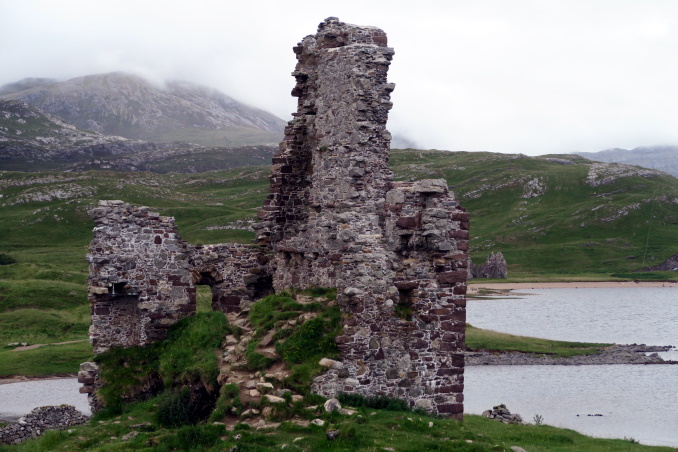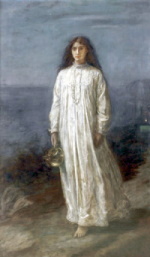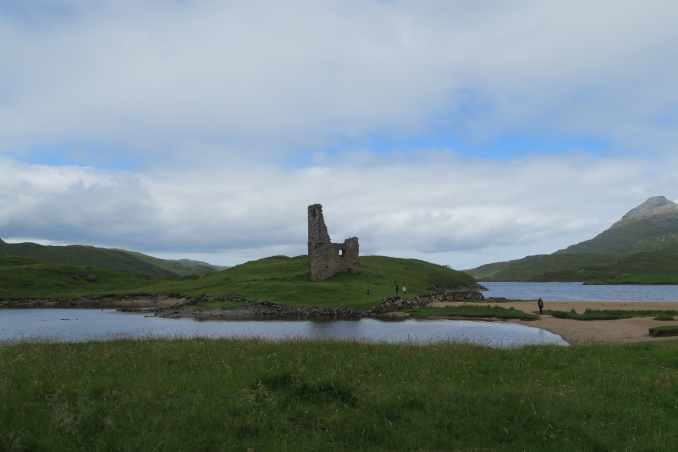Weeping ghost of Ardvreck Castle, Loch Assynt, once betrothed to the Devil

There is an air of mystery about Loch Assynt (Scottish Gaelic: Loch Asaint) in Sutherland, Scotland. A freshwater loch, it lies in a spectacularly beautiful setting surrounded by the mountains in the area of Assynt. Noted for its wonderful landscape its has, along with neighbouring Coigach, been designated as the Assynt-Coigach National Scenic Area (NSA). NSA's are areas in Scotland identified for their exceptional scenery with a conservation designation that protects them from inappropriate development. Loch Assynt is beautiful and takes its mood from the many changes in weather conditions that take place in this part of Scotland. Sometimes the water is still, calm and like a mirror, reflecting the magnificent surrounding snow capped mountains. At times the waters are whipped up by the winds that sweep down the hillsides. At its most mysterious it is shrouded by a mist that swirls over the flat surface of the Loch. Where every sound; some that can be identified and others that can't, echo around the water's edge. It is the type of setting that is ripe for stimulating the imagination.

Scotland, like other Celtic nations, abounds in myths, folklore and legend stretching far back into prehistory, many of which are tied to specific locations be they forests, lochs, glens, mountains, ancient burial chambers, cairns or darkened corners of old towns and cities. Often fuelled by actual historic events involving dark deeds, Scotland’s battlegrounds, old houses and castles are also noted for stories of the supernatural and ghostly activity. Castles that stand in remote landscapes can be particularly suggestive of this type of paranormal phenomena. Ardvreck Castle is one such place. The ruins of Ardvreck Castle stand on a rocky promontory at the edge of Loch Assynt. Built towards the end of the 15th century it was the seat of the MacLeods of Assynt (Scottish Gaelic: Asainte). Originally a three or four storey rectangular building it was later extended and the accommodation improved with the addition of a tower. Like many Scottish castles Ardvreck has a dark and troublesome history. It has been the site of sieges, murders and executions involving inter-MacLeod fighting as well as battles with traditional enemies. It was the place where James Graham, Marquis of Montrose, was imprisoned in 1650 after defeat at the Battle of Carbisdale. He met a very grisly end after being transported to Edinburgh where he was executed on 21 May 1650, by hanging, drawing and quartering. Ardvreck Castle was lost to the MacLeods in 1672 when the MacKenzies took the Castle after a 14 day siege.
Given the history of the site maybe it is of no surprise that the Castle is said to be very haunted. Ghosts include that of the weeping daughter of a MacLeod chief. She took her own life by throwing herself from a window of the castle and drowned in Loch Assynt after being fooled into marrying the Devil. It was said to have been part of a pact entered into in order to save the castle for her father. It is reported that she can be seen walking along the beach close to the castle. When the mists shroud the Loch some claim that her presence can still be heard by the sounds of heart rending sobs that are both unsettling and fill those that hear it with overwhelming sorrow. There is a variation in this story of MacLeod’s lost daughter, Eimhir, and her continued presence at Loch Assynt. There are some who hold to the story that instead of leaping to her death, she survived and hid in the caves under the Loch. Where she remained in hiding from the devil to whom she was betrothed. This new existence under the water led to her transformation into a mermaid and so becoming the elusive creature in the Loch known as the ‘Mermaid of Assynt’. When the level of the water in the Loch rises, it is said that it is because of her tears being shed in lament for her previous life. Rather than a mermaid others describe the creature as a Selkie which is a Scottish mythological creature capable of shapeshifting and taking another form. Scottish castles, however, tend to offer more than one ghostly apparition. So those visiting Ardvreck Castle, who do not hear or see the ghost of the daughter of MacLeod, might just catch a glimpse of another ghost who wanders the ruins. That of a mysterious man dressed all in grey who has been suggested to be the ghost of the unfortunate executed Marquis of Montrose or someone forever damned for being involved in his betrayal.

Legends and myths, such as the weeping Mermaid of Assynt, are often used to give an explanation for the physical features of an area. There are examples of this throughout the Celtic lands. One such is the Devil's Bit (Irish: Bearnán Éile) mountain in County Tipperary, Ireland which rises to a level of 1570 feet (478m) above sea level. There is a small gap in the mountain between one outcrop of rock and another small plateau. A gap, according to local legend, created by the devil taking a bite from the mountain. He broke his teeth taking this bite and spat the Rock of Cashel from his mouth to where it now stands about 20 miles (30 km) away. In the case of the Inchnadamph (Scottish Gaelic: Innis nan Damh) the area of Assynt surrounding Ardvreck Castle, the devil also played a part in the local geography. When angered by the broken promise of marriage he summoned meteoric rocks to fall. Scientific findings do indicate that north west Scotland was struck by an object from space around 1.2 billion years ago. Causing a massive impact and scattering material over a large part of the region. The Moine Thrust Belt, a geographic fault line around Assynt, is in legend also said to have been caused by the devil infuriated by the broken promise of marriage to the now weeping ghost of Ardvreck Castle beside Loch Assynt.
Content type:
- Scottish
Language:
- English





